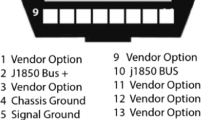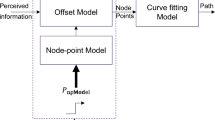Abstract
Our main objective was to develop a new driving assistance system that could help less experienced drivers improve their driving skills. We describe a statistical method we developed to extract distinctions between experienced and less experienced drivers. This paper makes three key contributions. The first involves a technology for feature extraction based on AdaBoost, which selects a small number of features critical for operation between experienced and less experienced drivers. The second involves a simple definition for experienced and less experienced drivers. The third involves the introduction of wavelet transforms that were used to analyze the frequency characteristics of driver operations. We performed a series of experiments using a driving simulator on a specially designed course that included several curves and then used the proposed method to extract features of driving operations that demonstrated the differences between the two groups.














Similar content being viewed by others
References
Kato, H., Kobayashi, S.: Factors contributing to improved fuel economy in eco-drive. J. Soc. Automot. Eng. Jpn. 62(11), 79–84 (2008) (in Japanes-e)
Murphey Y L., Milton R., Kiliaris L.: Driver’s style classification using jerk analysis. Computational intelligence in vehicles and vehicular systems, CIVVS ‘09. IEEE workshop, pp. 23–28 (2009)
Chandrasiri N.P., Nawa K., Ishii A., Li S., Yamabe S., Sato Y., Hirasawa T., Suda Y., Matsumura T., Taguchi K.: Driver skill analysis using machine learning: the full curve and curve segmented cases, The 12th International Conference on ITS Telecommunications, pp. 542–547 (2012)
Odenheimer, G.L., Beaudet, M., Jette, A.M., Albert, M.S., Grande, L., Minaker, K.L.: Performance-based driving evaluation of the elderly driver: safety, reliability, and validity. J. Gerontol. Med. Sci. 49(4), 153–159 (1994)
Ferguson, S.A.: Other high-risk factors for young drivers. J. Saf. Res. 34, 71–77 (2003)
Tada, M., Ohmura, R., Futoshi Naya, Noma, H., Toriyama, T.: Analysis of steering control behavior using 3D-accelerometers [in Japanese]. CVIM 93, 233–240 (2006)
Yamada M., Yamashita K., Yamasaki H., Kawasumi M., Yamada M., Yamamoto S., Nakano T.: Study on measurement and evaluation of novice driving ability, 10th Symposium on ITS peer-review proceedings, 1-D-4, pp. 1–6 (2011)
Tokunaga, R.A., Asano, M., Munehiro, K., Hagiwara, T., Kunugiza, K., Kagaya, S.: Effects of curve designs and road conditions on driver’s curve sharpness judgment and driving behavior. J. East. Asia Soc. Transp. Stud. 6, 3536–3550 (2005)
Li S., Yamaguchi D., Sato Y., Suda Y., Hirasawa T., Takeuchi S., Yoshioka S.: Differentiating skilled and unskilled drivers by using an Adaboost classifier for driver’s operations. 18th World Congress on Intel-ligent Transport Systems, TS92-3044, pp. 1–11 (2011)
Zhang, Y., Lin, W.C., Chin, Y.-K.S.: A pattern-recognition approach for driving skill characterization. IEEE Trans. Intell. Transp. Syst. 11(4), 905–916 (2010)
Viola, P., et al.: Robust real-time object detection. Int. J. Comput. Vis. 57(2), 137–154 (2001)
Tamura, A., Morooka, K., Kurazume, R., Iwashita, Y., Uchida, S., Hara, K., Nakanishi, Y., Hashizume, M., Hasegawa, T.: Trachea and esophagus classification by AdaBoost. IEICE Trans. Inf. Syst. (Japan. Ed.) J92-D(12), 2249–2260 (2009)
Mao, J., Jain, A.K.: Artificial neural networks for feature extraction and multivariate data projection. IEEE Trans. Neural Netw. 6(2), 296–317 (1995)
Watanabe S., Furuhashi T., Obata K., Uchikawa Y.: A study on feature extraction using a fuzzy net for off-line signature recognition. Neural Networks, 1993. IJCNN ‘93-Nagoya. Proceedings of 1993 International Joint Conference, vol. 3, pp. 2857–2860 (1993)
Lerner B., Guterman H., Aladjem M., Dinstein I.: Feature extraction by neural network nonlinear mapping for pattern classification. The 13th International Conference on Pattern Recognition, ICPR13, vol. 4, pp. 320–324 (1996)
Kar, C., Mohanty, A.R.: Monitoring gear vibrations through motor current signature analysis and wavelet transform. Mech. Syst. Signal Process. 20, 158–187 (2006)
Author information
Authors and Affiliations
Corresponding author
Rights and permissions
About this article
Cite this article
Li, S., Yamabe, S., Sato, Y. et al. Learning Characteristic Driving Operations in Curve Sections that Reflect Drivers’ Skill Levels. Int. J. ITS Res. 12, 135–145 (2014). https://doi.org/10.1007/s13177-014-0083-2
Received:
Revised:
Accepted:
Published:
Issue Date:
DOI: https://doi.org/10.1007/s13177-014-0083-2




